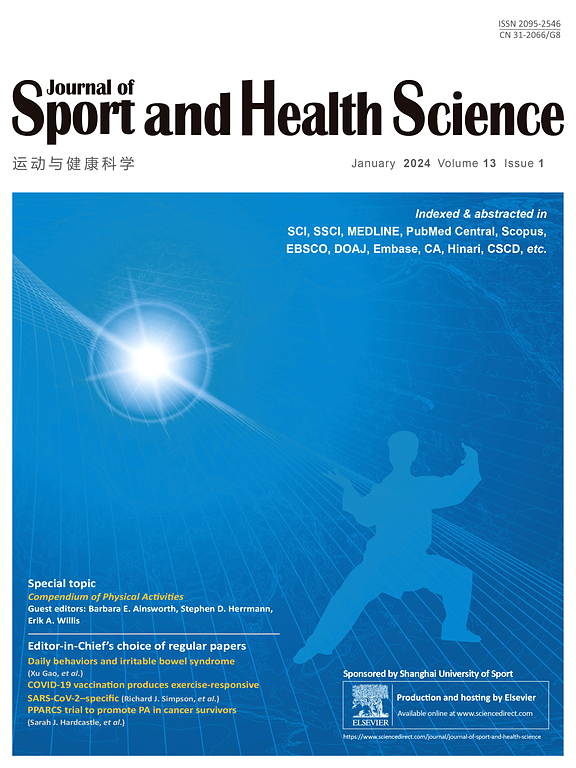Physical activity, genetic predisposition, and incident cardiovascular disease: Prospective analyses of the UK Biobank.
IF 10.3
1区 医学
Q1 HOSPITALITY, LEISURE, SPORT & TOURISM
引用次数: 0
Abstract
BACKGROUND It is unclear whether physical activity can benefit participants with high genetic predisposition to cardiovascular disease. We examined the joint associations of intensity-specific physical activity and genetic predisposition (based on polygenetic risk score) with incident coronary heart disease (CHD), stroke, and atrial fibrillation (AF). METHODS This prospective cohort study included 303,950 adults (age = 56.4 ± 8.0 years, mean ± SD; 52.5% females) from the UK Biobank with physical activity and disease-related genotypes. Moderate-to-vigorous physical activity (MVPA) and intensity-specific activity was classified according to volume (e.g., MVPA was classified as none, low, medium, and high). Genetic predisposition for CHD, stroke, and AF were classified as low (Quintile 1), intermediate (Quintiles 2-4), and high (Quintile 5). RESULTS During 11.6 ± 2.1 years of follow-up: 19,865 CHD; 7907 stroke; and 16,688 AF events occurred. Compared to the no MVPA and high genetic risk group, we observed lower CHD risk for increasing levels of MVPA over and above genetic risk groupings. These associations were primarily driven by vigorous-intensity activity. For example, in the high genetic risk group, those with low vigorous-intensity activity levels (compared to none) had a hazard ratio (HR) of 0.78 (95% confidence interval (95%CI):0.72-0.86) compared to an HR of 0.90 (95%CI: 0.83-0.98) for low moderate-intensity activity levels. For stroke incidence, we observed a protective association for MVPA across genetic risk groups that was mostly driven by moderate-intensity activity volume. Among the high genetic risk group, low moderate-intensity had an HR of 0.77 (95%CI:0.66-0.90), whereas low vigorous-intensity had no association (HR = 0.95, 95%CI:0.82-1.09). We did not observe a consistent joint association of MVPA and AF genetic predisposition. CONCLUSIONS We observed lower CHD and stroke risk for low to high MVPA among participants with high genetic predisposition. The associations of moderate- and vigorous-intensity activity volume differed considerably across cardiovascular disease sub-types. Overall, our findings suggest vigorous intensity activity may mitigate genetic predisposition for CHD while moderate intensity activity may be associated with similar effects for stroke. Joint associations were less consistent across AF genetic predisposition groups. Our results inform precision medicine approaches and future lifestyle modification interventions by quantifying the potential benefits of physical activity among at-risk individuals.体育活动、遗传易感性和心血管疾病:英国生物银行的前瞻性分析。
背景:目前尚不清楚体育锻炼是否能使心血管疾病高遗传易感性的参与者受益。我们研究了强度特异性体力活动和遗传易感性(基于多遗传风险评分)与冠心病(CHD)、中风和心房颤动(AF)的联合关联。方法本前瞻性队列研究纳入303950名成人(年龄 = 56.4±8.0岁,mean±SD;52.5%女性),来自英国生物银行,具有身体活动和疾病相关基因型。中度至剧烈体力活动(MVPA)和强度特定活动根据体积进行分类(例如,MVPA分为无、低、中、高)。冠心病、中风和房颤的遗传易感性分为低(1分位数)、中(2-4分位数)和高(5分位数)。结果随访11.6±2.1年:冠心病19,865例;7907中风;发生了16688次AF事件。与无MVPA和高遗传风险组相比,我们观察到MVPA水平升高高于遗传风险组的冠心病风险较低。这些关联主要是由剧烈运动引起的。例如,在高遗传风险组中,低强度运动水平(与无运动水平相比)的风险比(HR)为0.78(95%可信区间(95% ci):0.72-0.86),而低中等强度运动水平的风险比(HR)为0.90 (95% ci: 0.83-0.98)。对于卒中发病率,我们观察到MVPA在遗传风险组中的保护性关联,主要由中等强度的活动量驱动。在高遗传风险组中,中低强度的风险比为0.77 (95%CI:0.66-0.90),而低强度的风险比无相关性(HR = 0.95,95%CI:0.82-1.09)。我们没有观察到MVPA和AF遗传易感性的一致联合。结论:我们观察到在高遗传易感性的参与者中,低至高MVPA的冠心病和卒中风险较低。在不同的心血管疾病亚型中,中等强度和高强度活动量的相关性存在显著差异。总的来说,我们的研究结果表明,剧烈运动可能减轻冠心病的遗传易感性,而中等强度的运动可能对中风有类似的影响。联合关联在房颤遗传易感性群体中不太一致。我们的研究结果通过量化高危人群体育锻炼的潜在益处,为精准医学方法和未来的生活方式改变干预提供了信息。
本文章由计算机程序翻译,如有差异,请以英文原文为准。
求助全文
约1分钟内获得全文
求助全文
来源期刊

Journal of Sport and Health Science
SPORT SCIENCES-
CiteScore
18.30
自引率
1.70%
发文量
101
审稿时长
22 weeks
期刊介绍:
The Journal of Sport and Health Science (JSHS) is an international, multidisciplinary journal that aims to advance the fields of sport, exercise, physical activity, and health sciences. Published by Elsevier B.V. on behalf of Shanghai University of Sport, JSHS is dedicated to promoting original and impactful research, as well as topical reviews, editorials, opinions, and commentary papers.
With a focus on physical and mental health, injury and disease prevention, traditional Chinese exercise, and human performance, JSHS offers a platform for scholars and researchers to share their findings and contribute to the advancement of these fields. Our journal is peer-reviewed, ensuring that all published works meet the highest academic standards.
Supported by a carefully selected international editorial board, JSHS upholds impeccable integrity and provides an efficient publication platform. We invite submissions from scholars and researchers worldwide, and we are committed to disseminating insightful and influential research in the field of sport and health science.
 求助内容:
求助内容: 应助结果提醒方式:
应助结果提醒方式:


